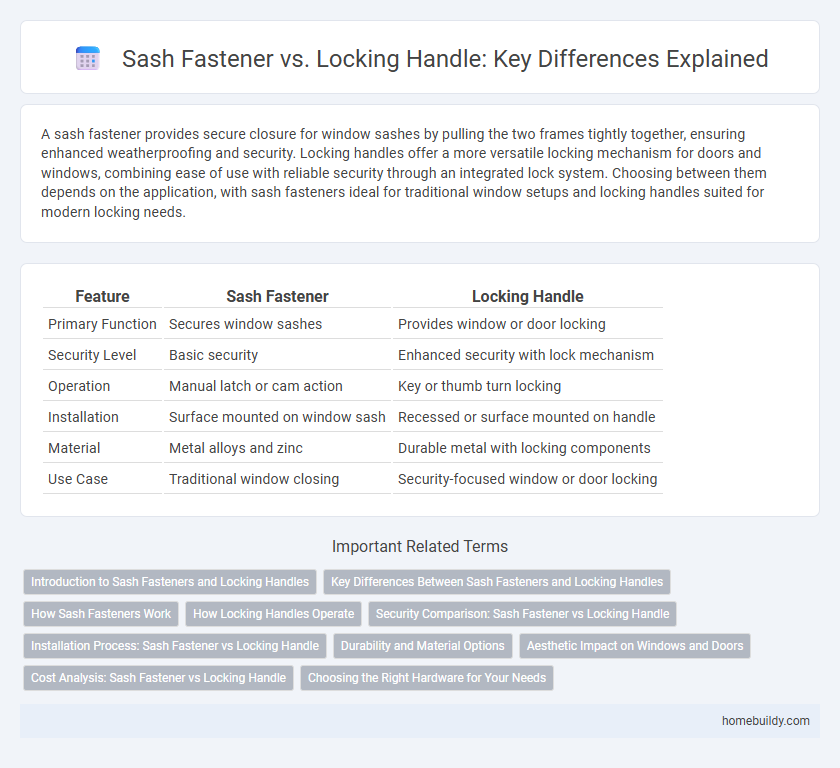A sash fastener provides secure closure for window sashes by pulling the two frames tightly together, ensuring enhanced weatherproofing and security. Locking handles offer a more versatile locking mechanism for doors and windows, combining ease of use with reliable security through an integrated lock system. Choosing between them depends on the application, with sash fasteners ideal for traditional window setups and locking handles suited for modern locking needs.
Table of Comparison
| Feature | Sash Fastener | Locking Handle |
|---|---|---|
| Primary Function | Secures window sashes | Provides window or door locking |
| Security Level | Basic security | Enhanced security with lock mechanism |
| Operation | Manual latch or cam action | Key or thumb turn locking |
| Installation | Surface mounted on window sash | Recessed or surface mounted on handle |
| Material | Metal alloys and zinc | Durable metal with locking components |
| Use Case | Traditional window closing | Security-focused window or door locking |
Introduction to Sash Fasteners and Locking Handles
Sash fasteners are hardware components designed to secure window sashes, providing a tight seal and enhancing security by preventing the sash from being opened from the outside. Locking handles combine the function of a handle and a lock, enabling easy operation while ensuring the window remains securely locked when not in use. Both sash fasteners and locking handles play crucial roles in window safety and functionality, yet locking handles often offer added convenience through integrated locking mechanisms.
Key Differences Between Sash Fasteners and Locking Handles
Sash fasteners primarily secure window sashes by tightly joining two frames, ensuring weather resistance and enhanced security, whereas locking handles focus on providing a controlled locking mechanism integrated with window or door hardware. Sash fasteners are typically simpler in design and installation, often used in traditional or sliding windows, while locking handles offer ergonomic grip and ease of operation for modern windows and doors. The key difference lies in functionality: sash fasteners emphasize a tight seal and sash alignment, whereas locking handles prioritize user control and multi-point locking security.
How Sash Fasteners Work
Sash fasteners secure window sashes by drawing two adjacent sashes tightly together, creating a seal that improves insulation and security. Unlike locking handles, which rely on mechanical grips or latches, sash fasteners utilize a rotating arm or cam mechanism to pull and hold sashes in place. This simple yet effective design minimizes air infiltration and enhances overall window stability without requiring complex hardware.
How Locking Handles Operate
Locking handles operate by engaging a locking mechanism that secures the sash in place, typically using a cam or lever system to prevent unauthorized or accidental opening. These handles provide enhanced security compared to standard sash fasteners by requiring manual disengagement to release the lock. Their design ensures durable operation and increased resistance against forced entry, making them ideal for applications where safety and security are priorities.
Security Comparison: Sash Fastener vs Locking Handle
Sash fasteners provide a reliable security mechanism by securely holding windows or doors closed, but locking handles offer enhanced protection through integrated locking features that prevent unauthorized opening. The locking handle's design delivers superior tamper resistance compared to traditional sash fasteners, which rely mainly on mechanical pressure for closure. For higher security requirements, locking handles are preferred due to their ability to incorporate keyed or multi-point locking systems.
Installation Process: Sash Fastener vs Locking Handle
The installation process of a sash fastener typically involves securing the fastener components onto the window sash and frame with screws, requiring precise alignment for optimal locking. In contrast, a locking handle installation often demands fitting the handle mechanism into a pre-cut slot, followed by securing it with screws or bolts, which may be more complex depending on the handle design. While sash fasteners generally offer straightforward installation with fewer parts, locking handles may require more detailed adjustments to ensure smooth operation and secure locking.
Durability and Material Options
Sash fasteners typically offer superior durability due to their robust metal construction, often made from stainless steel or brass, ensuring long-lasting performance in various weather conditions. Locking handles, while available in metal, frequently incorporate plastic components that can degrade faster under prolonged exposure to UV rays and moisture. Material options for sash fasteners are more diverse, including corrosion-resistant finishes that enhance lifespan compared to the limited material range found in locking handles.
Aesthetic Impact on Windows and Doors
Sash fasteners offer a sleek, low-profile design that seamlessly integrates with window and door frames, enhancing aesthetic appeal without disrupting architectural lines. Locking handles tend to be bulkier and more prominent, which can detract from the overall visual harmony of traditional or minimalist styles. Choosing sash fasteners supports a cleaner, more refined look while maintaining functionality in securing windows and doors.
Cost Analysis: Sash Fastener vs Locking Handle
Sash fasteners typically offer a more cost-effective solution compared to locking handles, with lower initial purchase prices and reduced installation expenses due to simpler mechanisms. Maintenance costs for sash fasteners are often minimal given their straightforward design, whereas locking handles may incur higher service fees due to complex components and security features. Overall, sash fasteners present a budget-friendly option for securing windows without compromising basic functionality.
Choosing the Right Hardware for Your Needs
Sash fasteners provide a secure and traditional method for window locking, ideal for enhancing aesthetic appeal and maintaining classic window designs. Locking handles offer enhanced security features and ease of use, making them suitable for high-traffic areas or commercial settings where safety is paramount. Selecting the right hardware depends on balancing security requirements, design preferences, and the specific functionality needed for your window system.
Sash fastener vs Locking handle Infographic

 homebuildy.com
homebuildy.com